
“Re-Modernologio” Phase3: Traces of Scenery
February 18 (Sun) ~ March 25 (Sun), 2012 10:00 - 18:00 / Free
Amanda BELANTARA
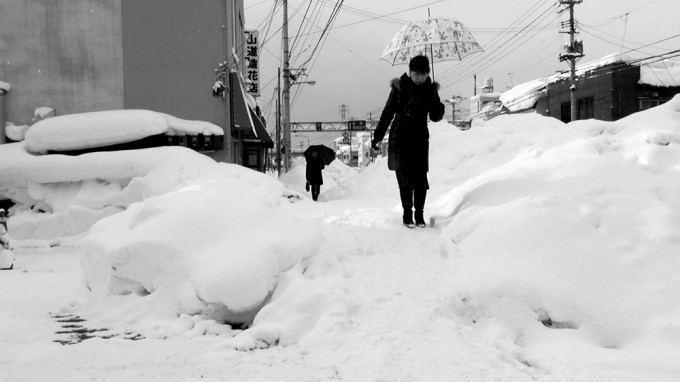
Moments (c) Amanda BELANTARA
Sounds to See and Images to Hear
KONDO Yuki
Impressive images shot by a fixed point observation are shown in the work Moments, in which few explanations are inserted and little camerawork with suggestive meanings is employed. According to Belantara, she stood in a street holding her camera up to capture patiently what was happening there, like KON Wajiro, a founder of modernology, used to sit at a street corner and record what he closely observed about passers-by. In front of the fixed camera, cars, people and snowballs quietly go past. Soon after some sounds are heard from where there is nobody, someone steering a sled or walking thrusting the umbrella into snow appear between an opening in the snow wall, and are swallowed up behind it. Though they are reflecting images of the town scenery, some sounds diminish and sounds specific to snow are intensified─sounds of footsteps threading the snow hard, snow shoveled, snow falling, snow thawing and snow blowing hard against something. Often only images are shown in silence. In the scene showing a truck dumping a huge chunk of snow into the sea, only burbling sound of melting snow is heard. Those restrained sounds and black-and-white images that seem to have lost colors reveal the scenery of a snowy town more vividly than its actual scenes. Thus this piece brings about a set of mental images of the scenery of the town reflecting its stillness, how people live enduring snowstorms, and how residents have their freedom of action restricted by snow.
Amanda BELANTARA, who studied visual anthropology, in which ethnology and cultural anthropology are researched by using images, sounds and occasionally smells, views present-day society and culture in an audiovisual perspective, and inquires into people’s lives and activities from that angle. It means that she approaches the subject by recording lives and activities of people living now and there as faithfully as possible through sounds and images. In this meaning, her “interest in visual anthropology” could be a clue to understand her work. On the other hand, her approach to collect and present them is not so much to explain, analyze or express her intention clearly in a specific framework as to get feedback as a collective representation of empirical memories of the subjects and viewers on her cut-out sounds and world of image. According to Belantara, “ ‘allocation of acoustic arena resources mirrors the culture’s values’[1] means that we listen to ‘what’ and ‘how’ as the product of a cultural process,”[2] and she focuses on sounds produced through people’s acts in particular along with images to cut out the world. In this case, sounds get involved in her work in several contexts: one is to reconstruct and present some situations and aspects in the society by means of collected sounds and images different from written texts and language. Another is that Belantara herself uses audiovisual information as a means to understand local communities and residents, and the third is to explore how people respond to “sounds” and research on their different responses and how sounds make impacts on the unconscious domain.
Her video work Lifelibrary (2007) depicts comprehensively the existence of library through sounds. In the circumstances where people should keep quiet, sounds are audible from all quarters: whispers like natural sounds, rhythmic sounds of doing such a routine job as putting books back to shelves and lending of books like an efficient skilled craftsman, loud sounds of footsteps, monotonous electronic sounds coming out at the time of handling text materials, sounds of turning the pages of a book, and sounds of writing with a pencil. All those sounds coming out of the specific place of a library are made by people who act and behave according to regulations, and are collected through special microphones. They are dubbed onto images showing different situations that are happening in the library. They are not sounds recorded naturally and neutrally by the video apparatus, but they sound with a feeling of physical closeness as if we were listening carefully to that sound only. What is reconstructed here is not a library as facilities but a comprehensive “image of library” which people get involved in and perceive. As in the folklore of “blind men and an elephant,” each sound fragment as material does not tell us independently what is happening there and where it is, thus not revealing the whole. However, each sound is the actually recorded sound of that part and we realize it, and when they are all combined, we are able to capture a clear overall picture accompanied with something inaudible and invisible.
In contrast, Mimi ga Kyutto naru / Ears are Dazzled, touched by sound (2009), which was produced in the artist-in-residence program at Akiyoshidai International Art Village, shows that sounds can be a means to know of an unknown place. In the case of Lifelibrary, the subjects to be filmed had already been decided and were interviewed beforehand. In addition, the place where the research was made was “library,” the place where its knowledge/recognition could be shared. In the Mimi ga Kyutto naru piece, on the other hand, the materials for the subject to be shot and recorded are discovered from the description of everyday sounds made by locals in this unknown area. What is more, sounds verbalized as “sound diary” are first collected in this work, and by combining this inner soundscape expressed in words with general, actual sounds and images, the sound and image seem to be connected through a medium of words. Cinematic cuts and camerawork make up a story in this verbalizing process, and it makes us aware of a viewpoint at a distance “looking” at lives of people, who are the filmed subject. While the moving image causes a sense of distance seen through someone’s framework, audible information we actually hear gives us a feeling of physical closeness. This gap between the two, image and sound, makes us feel that the viewer’s perception and the description of sounds that people in the moving images provide do not always match. Since this disparity stems from each person’s history of life and experience, sound-related memories could express something delicate.
Kinoko-phonography (started in 2010) conducted as a project/event might have originated from her interest in different responses to those sounds. It is a project as well as an event to collect sounds all over the world, listen to them together with all participants to discuss. What is interesting here is that Belantara has collected sounds based on two categories: free application and application with themes. The former collection probably depicts sounds and situations, which people pay special attention to in everyday life in the case of Mimi ga Kyutto naru, and the latter is a collection of sounds that depict soundscape on a specific topic and their different impressions, as in the case of Lifelibrary. Here, you could realize Belantara’s differential kind of interest in different responses and impressions of sounds as well as her interest in actual sounds of all kinds.
Moments produced at ACAC this time is also her work depicting Aomori residents’ lives through sounds and images. With “snow” as the focus, however, this piece seems to be an aggregate of situations and impressions viewed through images and sounds. Belantara did not intend to take up snow for the theme from the beginning. As she did in previous pieces, at first she began to interview people asking them sound-related questions, about accounts of soundscape and their impressions of the area as a means to learn about the district. However, in Aomori hit with the heaviest snowfall they’ve had for several years, many people talk about snowy scenery, and in fact, when she visited such places for inspection, all she saw was the ground carpeted with deep snow and she found nothing else. People shut themselves up quietly in their houses, there is hardly anyone in the street, and only traces of some people’s activities are left on the snow. Even if there were people’s activities going on, they would be hidden behind tall snow walls rising skyward. She said that the city of Aomori at this time when everything was hidden under snow was exactly “traces of scenery.”[3] Probably because she kept shooting the scenery of town standing at a fixed spot with all her camera and recording equipment on her shoulder at the time of the coldest and severest snowstorm, the sounds we hear are not for the soundscape formed by someone’s impressions and responses but they have more direct impact on us, so that we can feel her physical sensation strongly in her perspective on sounds, though the moving images are faithfully depicting the scenes.
The questions that Belantara asked local people are limited, intentional and directional. Nevertheless, the completed work turned out to be something different from the materials she collected during her fieldwork. I think that it is partly because her approach to the choice of the subject and the construction of image composition is empirical. I believe, on the other hand, that while the subject is tape-recorded through the medium of sound description objectified in this work, situations are comprehensively depicted with a feeling of closeness, because not only the soundscape as someone’s experience but also her physical aspect is involved in there. It is soundscape as a subjective experience, and it seems that the landscape has been dissolved and reconstructed through her physical experience.
Images, in which incidental moments are captured by a camera fixed to wait patiently for an incident to happen, are cut out as a story, but they are documentary in that the situation is filmed then and there. She does not mean to abstract the world through a camera, but tries to be neutral as to how far she should be from the subject or how images should be presented. On the other hand, it is the very reason why the disparities between images and sounds change the distance between the image and the viewer. It is also the reason why the work makes us feel the artist’s freezing body, and beautiful picturesque images framed before our eyes are given a double meaning of physical sensation and snow. Those images and sounds, while playing complementary roles with each other, show their situations separately to suggest strongly that there is something invisible and inaudible behind them. It seems that innumerable eyes, ears and sound sources are coming across at the point where the screen and sounds contact each other.
[1] Barry BLESSER and Linda-Ruth SALTER, Spaces speak, are you listening?: experiencing aural architecture, MIT Press, 2007, p. 29.
[2] Belantara in her artist talk on February 18, 2012.
[3] Her artist talk on February 18, 2012.
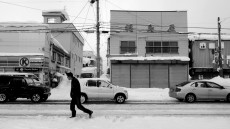
Moments
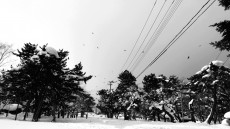
Moments
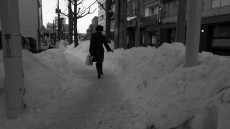
Moments

Moments
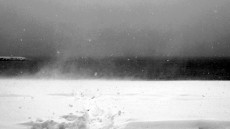
Moments

Moments
「再考現学 / Re-Modernologio」pahse3:痕跡の風景
2012年2月18日(土)~3月25日(日) 10:00 - 18:00/無料
air2011-4ja
アマンダ・ベランタラ
Amanda BELANTARA

《そのとき Moments》 (c) Amanda BELANTARA
音を見る、イメージを聴く
近藤由紀
固定されたカメラによって定点観測的に撮影された映像が印象的な≪そのとき Moments≫には、説明的な映像の挿入や意味深長な カメラワークはあまりみられない。ベランタラがいうように、それは考現学の今和次郎が東京の街角に座り、ノートを携え、目の間を通過する人々をただひたすら観察し記述していたように、ベランタラもまた街角に立ち、カメラを構え、辛抱強くそこで起きていることを捉えた記録でもある。固定されたカメラの前では、車や人あるいは雪の礫が静かに通り過ぎていく。あるいは人影のない風景に音だけが聞こえると思ったら、しばらくするとそりを引く人や、傘を突き刺しながら歩く人が雪の壁の隙間から一瞬姿を見せ、また雪の壁の中へと吸い込まれていく。町の風景の映像でありながら、いくつかの音が減じられ、雪に特化した音 —雪を踏みしめる音、雪をかく音、雪が落ちる音、雪が溶ける音、雪が吹き付ける音—が強められ、しばしば静寂のうちに映像のみを示す。大量の雪をトラック が海に捨てるシーンでは、海中に雪が溶けていく音だけをぽこぽこと響かせる。抑制されたそれらの音と色が失われたような白黒の映像は、現実の雪の町の風景 以上に雪の町の風景であり、その静けさ、吹雪に耐える時期の暮らし、雪によってあらゆることが制限されざるを得ない町の情況を反映した心的イメージの町の 風景としてたちあがっている。
映像、音、時には匂いなどを手がかりに民族学や文化人類学を研究する映像人類学 (Visual anthropology)を修めたアマンダ・ベランタラは、現代の社会や文化を視聴覚の視点からとらえ、その点から人々の生活や活動を探求する。それは音や映像によって今、そこに生きている人々の生活、行動をなるべく忠実に記述することで対象にせまろうとするものであり、そうした意味で、ベランタラの作品を知る際に「映像人類学的関心」というのは一つの手がかりとなる。一方で収集されたそれらは解説したり、分析したり、あるいはそのフレームによってある 意図を強く提示するというよりは、そこで切り取られた音や映像世界を、その撮影の対象者および鑑賞者のうちにある経験的記憶の集合体としてフィードバックされるような仕方で表されている。「『聴覚資源の配分は文化的価値を反映する』[1]ということ、それは音を文化的過程の所産として、私たちが何を聞くか、またどう聞くかということなのです」[2]とベランタラがいうように、ベランタラは映像とともに特に人々の行為によって生まれる音に着目し、世界を切り取る。この場合音はいくつかの意味においてベランタラの作品に関わってくる。一つは集められた音や映像により文字記述や言語とは別の仕方で情況や社会の様相を再構築し提示するということ、そしてもう一つはベランタラ自身が視聴覚情報をある社会やその土地の人々を知るための手段とするということ、そしてもう一つは「音」に対する人間の反応とその差異および無意識の領域への影響力についての探求であろう。
≪Lifelibrary≫(2009年)は、まさに音によって図書館という存在を包括的に記述した映像作品である。静かにしなければならないという情況の中であちらこちらから自然音のように聞こえてくる囁き声、配架や貸出し といった業務にまつわるルーティーンワークを熟練した職人のようにテキパキとこなすリズミカルな音、その中で響きわる足音、資料を操る際に発せられる電子音の単調な響き、本をめくる音、鉛筆を走らせる音。それらは図書館といったある限定された空間での、ある種行動を規定された人々の行動と振る舞いから発せられる音であり、特殊なマイクによって収集されたそれらの音は、図書館でおこるさまざまな場面の映像に再びかぶせられる。それらの音は、映像機器が中立的に録音した自然な音ではなく、注意深くその音のみを聞こうとした時の音のように身体的な近さをもって聞こえる。そこには施設としての図書館ではなく、人が関わり、知覚する包括的なイメージとしての「図書館像」が再構築されている。「群盲像を評す」ではないが、音という素材の断片は、それぞれ個々の素材ではそこで何が起きているか、そこがどこであるか分からず、全体を指し示すことはない。しかしそれぞれはそれぞれの部分での現実の記録であり、実感であり、それらが合わさることで聞こえない何か、みえない何かを伴った豊かな全体性を獲得するかのようである。
これに対し、音がある見知らぬ場所を知る手段となっているのは、秋吉台芸術村のアーティスト・イン・レジデンス・プログラムで制作された≪耳がきゅっとなる≫(2009年)であろう。≪Lifelibrary≫も事前に撮影対象にインタビューを行うなどしているが、そこでは撮影されるべき対象は決まっており、またそれは「図書館」という知識/認識として共有できる場での調査であった。一方ここでは未知の土地に住む人々の日常の音についての記述から、撮影/録音対象となる素材が発見される。さらにいえばこの作品ではまずさきに「音の日記」という言語化された音が集められており、言語化された内的な音風景を再び一般的現実的な音や映像と結びつけることにより、言語を介し音と映像が結びついているようにみえる。映画的なカット割りやカメラワークは、言語化される過程のある物語を形成するものであり、それにより被写体である人々の生活を「見る」離れた視線を感じさせる。だが映像である種の他者のフレームが生む距離を感じさせる一方で、 実際に耳にする聴覚情報が与えるのは身体的な近さである。このずれは映像に登場する人々が語る音の記述と、鑑賞者の感覚が必ずしも一致しないということも感じさせる。その差異はそれぞれの人生の歴史や経験に由来しており、それ故に音の記憶は繊細な何ものかを表しうるのだろう。
プロジェクト/ イベントとして行われているキノコフォノグラフィ(2010年より開始)は、こうした音の反応に対する差異への関心から生まれたのではないだろうか。これは世界中から音を集め、それを参加者とともに聞き、音について語るというプロジェクトでありイベントである。ここで興味深いのは、ベランタラが自由応募とテーマ応募の二つの部門を設けて音を集めていることである。自由応募の音は≪耳がきゅっとなる≫の場合のように、そこここに暮らす人々の日常において気になる音とその情況の記述の収集であり、テーマ部門の音収集は≪Lifelibrary≫のように、ある一つの対象に対する音風景とその印象の差異についての収集となるのではないだろうか。ここにはベランタラの様々な音そのものについての関心とともに、音についての反応や印象の差異についての微分的な関心を見ることができるだろう。
今回ACACで制作された≪そのとき Moments≫も滞在制作した青森市の人々の生活を音と映像で切り取った作品ではあるが、「雪」が切り口となることで焦点が絞られ、映像と音によってある情況、あるイメージを一つの集合体として映す映像となっているように思われる。ベランタラは最初から雪をテーマにしようとした訳ではなく、この作品においてもそれまでと同様にまず土地を知るための手段として音風 景の記述や音にまつわる質問他、土地についての印象など人々へのインタビューを行った。しかし数年ぶりの大雪に見舞われた青森では、多くの人が雪の風景に ついて語り、また実際にそれらの場所に調査に出かけても、全ては深い雪に覆われ、何もみつけることができない。人々はひっそりと家にこもり、町に人影はほとんどなく、道には誰かが何かの活動をした痕跡だけが雪の上に残されていた。またたとえ人の活動があったとしても、それらは高くそびえ立った雪の壁の向こ う側に隠されている。あらゆるものが雪の層の下に隠されていたこの時期の青森の町はまさに「痕跡の風景」であったという[1]。 一方でたくさんのカメラや録音機材を担ぎ、最も寒さと風雪が厳しかった時期にじっと一点に立ち町を観察し、撮影を続けたからであろうか、映像が場の忠実な記述である一方で、そこで聞こえる音は誰かの印象や反応によって形作られた音風景ではなく、より直接的であり、その音の視点の中心にはベランタラの身体的な感覚が強く感じられる。
ベランタラが地域の人々に行った質問は限定的であり、意図的であり、ある方向性が感じられた。にもかかわらず完成 された作品は、それらフィールドワークにおいて集められた資料とは別のものとなった。それは対象の選択や映像の構成を経験的に構築していこうとするベランタラの志向でもあるのだろうが、この作品において対象化された音の記述が媒介となってある対象が撮影/録音されていながら、近しい感覚をもってある情況が包括的に描き出されているのは、他者の体験としての音風景だけではなく、そこにベランタラの身体性が介在したからではないだろうか。それは主体的な経験としての音風景であり、ベランタラの身体的な経験を通してこの風景が解体され、もう一度再構築されているかのようである。
出来事が起るのをじっと待つような固定されたカメラが捉えたさまざま偶然の瞬間の映像は、それだけで一つの物語として切り取られているが、今そこにある情況を撮影するという点において、記録的である。それはカメラを用いることで世界を抽象化しようとするものではなく、対象との距離においても、映像の提示の仕方においても中 立的であろうとする。だが一方でだからこそその映像と音の差異が映像と鑑賞者の距離を変容させ、作者の凍えるような身体性を感じさせ、目の前のフレームで切り取られた美しい絵画的な映像に、身体的な感覚と雪の両義性を与えているのではないだろうか。このように映像と音はそれぞれ補完しあいながらも別々の状態を示すことで、それらの背後に見えない何か、聞こえない何かをより強く暗示させる。そこには画面と音を接触点として無数の目と無数の耳と無数の音源が交差しているかのようである。
[1] 2012年2月18日のアーティスト・トークでの発言。

《そのとき》

《そのとき》

《そのとき》

《そのとき》

《そのとき》

《そのとき》
